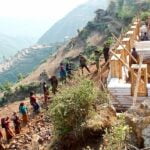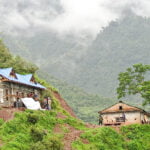Smita Magar
Kathmandu, 15th Jan 2011
On the first day of Nepali month Magh, (15th January) all Nepalese wake up to celebrate “Maghe Sankranti” as per their social, geographical and cultural background. While almost everyone enjoys it with special dishes made out of pure ghee and sweets like laddoo, fruits and sweet potatoes they have different reasons and beliefs about this festival.
One of the Nepal’s indigenous communities Tharu celebrates it as the New Year while Hindus have religious belief of salvation behind its celebration. In Jhumlawang, Maghe Sankranti is celebrated as the festival to worship sisters. It is like a ‘sister-day’. And, unlike a day celebration in other parts of the country, Jhumlawang celebrates it for 3 full days.
On the first day of festival, all brothers are busy worshipping their sisters with ‘nishro’.  A plate full of delicious foods, fruits, rice and some money is called Nishro which they gift to their sisters. It is also given to the cousin sisters so, whole day they are busy distributing it around the village and neighboring villages. Second day of festival is also ladies day. Early morning, girls form a group and go for ‘Magh khane’, like a picnic. They take all the food items, especially rice with them. As it is believed that they have to finish rice that day itself, they cook different food items out of it and enjoy the eating whole day. In between, they dance, sing and play different games as well.
A plate full of delicious foods, fruits, rice and some money is called Nishro which they gift to their sisters. It is also given to the cousin sisters so, whole day they are busy distributing it around the village and neighboring villages. Second day of festival is also ladies day. Early morning, girls form a group and go for ‘Magh khane’, like a picnic. They take all the food items, especially rice with them. As it is believed that they have to finish rice that day itself, they cook different food items out of it and enjoy the eating whole day. In between, they dance, sing and play different games as well.
In the evening, girls gather at chautara (meeting place of village) where all ages villagers are already there celebrating the festival by singing, dancing folk dance -paicharu and children playing ‘ping’ and ‘dhanu kadh’ (archery). The girls then dance ‘Hompai’ – a traditional dance. Through dance they make spectators laugh out loud with their funny moves and techniques.
The third day is celebrated with ‘Taro hanne ‘(archery competition) among men. Whoever hits the bull eye gets special treatment. They carry him round the village and feed them with delicious foods. Indigenous/ Magar culture expertise say this archery competition is a way of teaching/preparing the coming generation of hunting.
This way, Maghe Sankranti is celebrated with difference in Jhumlawang and neighboring villages as the ‘sister worshipping’ festival. Just like in Tihar, the festival of light, sisters worship their brothers, in this festival it is the sisters that are worshipped. This culture also points out that women are respected or at least tried to be given equal grounds. With that we can also say it is the festival that respects the siblings bond.
Wish you a Happy Maghe Sankranti!!!


